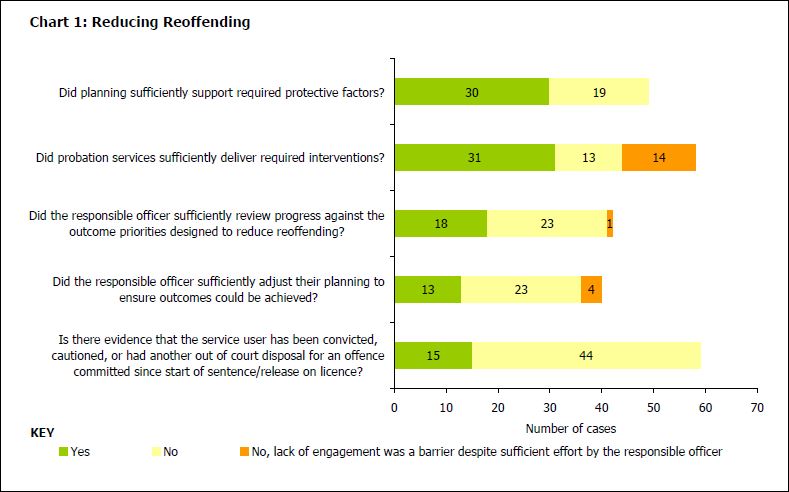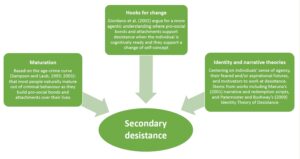Big difference in quality between NPS and CRC
The quality of CRC work was significantly lower than that we saw formerly in the Probation Trust, and was in some respects poor. Assessments and plans were often not good enough, and purposeful rehabilitation work was seen in too few cases. We expect to see public protection prioritised, yet we did not find evidence of this.
That is the overall verdict of Her Majesty’s Inspectorate of Probation on the work delivered by the Community Rehabilitation Company in Derbyshire in a report published last week (22 September 2016).
By contrast, inspectors were broadly pleased at the work being delivered by the National Probation Service in the county:
The NPS was in a better position. A strong, legacy culture of good professional practice and a focus on public protection prevailed. The quality of work was generally good and the NPS was effective in protecting the public and assisting the rehabilitation of offenders.
As I’ve said previously, it’s not my intention to blog on every Probation Inspectorate local Q&I inspection but this is only the third area inspection post the probation changes brought in by Transforming Rehabilitation and many people are eager to have an objective view on the quality of work being undertaken.
The first inspection of Durham also expressed serious concerns about the work of the CRC, while the second inspection about the work in York & North Yorkshire found both NPS and CRC generally performing and collaborating well.
The probation inspectorate inspects on a Police/PCC area basis, the CRC inspected in this report covers Derbyshire, Leicestershire, Nottinghamshire and Rutland and is operated by The Reducing Reoffending Partnership (RRP) — a Joint Venture between Ingeus, St Giles Trust and Change, Grow, Live.
Findings – National Probation Service
Inspectors found that although the NPS were not providing the CRC with complete information about risk of harm for all cases at the point of allocation, generally the standard of work was good:
- The work delivered by responsible officers, contracted providers and partner agencies to minimise the individual’s risk of harm to others was sufficient in most cases, underpinned by strong joint working arrangements.
- The start of order assessment was sufficient in most instances, leading to the creation of plans of work that addressed appropriate offending-related and protective factors.
- When positive rehabilitative work was required, it was generally undertaken. Where it was required but not delivered, it was usually because the offender failed to engage. Responsible officers kept the delivery of interventions under review, and, where significant changes occurred, they adjusted plans accordingly. The NPS was not, however, making full use of the extensive range of interventions offered by the CRC.
- Most of those supervised by the NPS were positive about their working relation-ships with their responsible officers. Most service users were meaningfully involved in drawing up their sentence plan. Their diverse needs were generally assessed and taken into account in planning and delivering the sentence. Several told us about the progress they had made that made them less likely to reoffend.
Findings – Community Rehabilitation Company
The inspectors report that RRP had concluded a major organisation redesign across its two large CRCs (covering the West and East Midlands) which included new organisational and management structures, premises and IT systems and which was midway through implementation. The new operating model proposed a customer service centre to provide administrative support to front-line staff who would be enabled in turn with new software to help manage cases efficiently and effectively. The model provided for an extensive suite of interventions from a wide range of providers.
The inspectors concluded that while this redesign was intended to bring in an ambitious positive model, in the meantime staff had been too preoccupied with managing change, rather than supervising offenders. They make a number of substantial criticisms:
- In too many instances, CRC staff did not make follow-up enquiries when insufficient information was provided by NPS court staff to them at the point of allocation. In too many instances, CRC staff had not fully reviewed all of the information about the case before undertaking their assessments. Risk of Serious Harm assessments, and risk management planning, were often not sufficient.
- The failure to deliver meaningful rehabilitative work to many domestic abuse perpetrators made it less likely that reoffending and public protection outcomes would be achieved.
- Many staff were concerned that they had not had sufficient training, or the practice experience and resources, to work effectively on the risks of harm posed by service users.
- Quality assurance was not routinely undertaken, and management oversight was not effective in making positive public protection outcomes more likely.
- Many CRC responsible officers considered their workloads unmanageable.
- Many initial sentence plans failed to specify the objectives of supervision or what service users needed to do to achieve the desired outcomes. Work to address offending-related factors was often not being delivered.
- Responsible officers were not keeping cases under review or adjusting plans when significant changes occurred. Many responsible officers were positive about the support provided by line managers, but understood that the amount of management attention being given to dealing with change, combined with reduced management resources, had meant that a focus on quality had been lost in recent months.
The chart below shows the inspectors findings from their inspections of both NPS and CRC cases:

Findings – Collaboration
Despite the CRC’s problems, inspectors found that generally collaboration and co-ordination between the two arms of the modern probation service were generally working well:
- Considerable effort had been put into maintaining positive working relationships between the CRC and the NPS, particularly in relation to courts and partnership arrangements. Well-organised court teams made sure that the quality of the pre-sentence report was generally satisfactory.
- Sentencers were kept appraised of the developments in relation to rehabilitation activity requirement days and the services that could be offered. The relationship between the CRC and NPS was positive but, due to teething problems with their new systems, some communication issues prevailed.
Conclusion
As stated before, this is the third of HMIP’s Quality and Inspection reports post-TR and it’s pleasing to see some improvements in the presentation of findings. I found the highlighting of examples of good and poor practice particularly helpful as well as quotes from frontline staff which clearly define the scale of the current challenge to deliver good quality probation supervision in their own words.
As you will see from the Chief Inspector’s conclusion to this inspection report (reproduced below), the work of the probation inspectorate has rarely been more badly needed:
The CRC has ambitious plans for an effective and modern probation service, to make a difference to people’s life chances and reduce re-offending. I welcome that, of course, but implementation of the planned changes has been troublesome and slow, and meanwhile standards have slipped. Leaders do need to focus on delivering good quality services today as well as improving tomorrow. The public can be reassured however that the National Probation Service in Derbyshire is managing high-risk offenders well.









2 Responses
This is particularly damning, & I wonder if it isn’t partly affected by a focus on rehabilitation over risk by some CRCs? Assessing underlying risk, as well as explicit risk, is also a skill which needs to be taught, & can take years to develop, as not all offender’s index offences will be DV related. And don’t get me started on the decision to produce verbal reports at court, rather than written reports, as this “time saving” activity can lead to risk issues being missed (especially if the index offence isn’t DV)..The problem isn’t just with the CRC. It’s a problem with cost cutting…grrr.
Thanks for your comment Anna. It is interesting that you suggest part of the cause might be CRCs’ prioritising rehabilitation over risk. Many of the Inspectorate’s recent reports suggest that the NPS is doing a good job on risk, but much less on promoting desistance.
Best Wishes